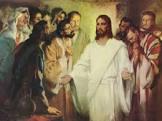
“We proclaim a Christ crucified, a stumbling block for Jews and foolishness to gentiles.” (1 Cor 1:23)
Luke was writing for a gentile audience. Being a gifted story-teller, his account of the walk to Emmaus, where Jesus opened the scriptures concerning himself, helped his readers see the working-out of God’s plan. He then linked this with the appearance of the Jesus to the disciples, including those returning from Emmaus. He uses the scene in the upper room to emphasise the fact that the risen Lord had a real body. He could eat and his friends could touch his wounds. This could have been a puzzle for the Greeks who believed in the separation of the body and soul at death.
If the gospel of Luke was a novel, Acts would be its sequel; the two run seamlessly togther. Having colourfully described Jesus’s appearances to his disciples, Luke shows how those men made his resurrection the central point of their preaching. As St Paul later declared: “If Christ has not been raised, your faith is futile and you are still in your sins.” (1 Cor 15:17)
They were so convinced of what they had seen and heard that they were prepared to suffer punishment, even death.